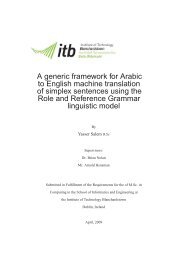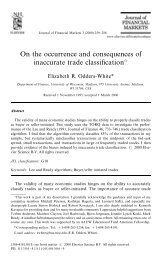8. Anne Lebeck, The Oresteia, CW 66 - Acsu Buffalo
8. Anne Lebeck, The Oresteia, CW 66 - Acsu Buffalo
8. Anne Lebeck, The Oresteia, CW 66 - Acsu Buffalo
Create successful ePaper yourself
Turn your PDF publications into a flip-book with our unique Google optimized e-Paper software.
Author(s): John Peradotto<br />
Reviewed work(s):<br />
<strong>The</strong> <strong>Oresteia</strong>. A Study in Language and Structure by <strong>Anne</strong> <strong>Lebeck</strong><br />
Source: <strong>The</strong> Classical World, Vol. <strong>66</strong>, No. 3 (Nov., 1972), pp. 167-168<br />
Published by: Classical Association of the Atlantic States
NOVEMBER 1972 THE CLASSICAL WORLD 167<br />
REVI EWS Walter Donlan and Robert D. Sider<br />
ANNE LEBECK. <strong>The</strong> <strong>Oresteia</strong>. A Study in Language and Structure. (Publica-<br />
tions of the Center for Hellenic Studies.) Washington: Center for Hellenic<br />
Studies, 1971; distr. by Harvard University Press. Pp. ix, 222. $<strong>8.</strong>50.<br />
<strong>Lebeck</strong>'s central thesis is that themes and images in the <strong>Oresteia</strong> unfold in in-<br />
tricate, significant patterns, and that the development of these patterns parallels<br />
and coincides with the development of gnomic statement and dramatic action.<br />
<strong>The</strong> peculiar form of this development is characterized by an introductory<br />
presentation of several major themes that is brief, problematical, enigmatic,<br />
"proleptic," followed (not always immediately) by recurrences which gradually<br />
elaborate its inchoate meaning, replacing obscurity with clarity, problem with<br />
solution, perplexity with equanimity, discord with harmony. This form is<br />
discovered within each single lyric, in the development from lyric to lyric, and<br />
from play to play.<br />
In the first of four parts the study concentrates on this development of theme<br />
and image in and between the lyric portions of the Agamemnon, especially the<br />
parodos. Parts three and four submit the Choephoroi and the Eumenides to the<br />
same kind of analysis. Part two broadens its scope to the whole trilogy to<br />
demonstrate "the way images are interwoven by associative repetition." No<br />
short review could do justice to the richness of <strong>Lebeck</strong>'s analysis; let a few<br />
instances serve to exemplify its pattern. Weak old age and the honor due it is<br />
a theme introduced by the Argive elders in the parodos of the Agamemnon to<br />
describe themselves, but it prepares us for a prominent concern in the Eumen-<br />
ides, the presumed forceful suppression and dishonor of the Erinyes at the hands<br />
of the younger Olympians with a new form of justice. Similarly, the central<br />
meaning of the famous Zeus-"hymn" is the search for his nature through his<br />
name, only partially and vaguely communicated here in the words Dios and<br />
etetumos (165-<strong>66</strong>); but this half-buried etymology becomes explicit later in io ie<br />
diai Dios panaitiou panergeta ktl. (Ag. 1485-87), and teleion hupsiston Dia (Eum.<br />
28), and reaches full dramatic realization in the outcome of the trilogy. More<br />
complicated is the theme of the endless flow of blood in the Agamemnon which<br />
appears successively as image (179-80, 239, 958-60, 1121-22), as dramatic action<br />
and concrete object (in the carpet scene), and finally as direct lyric statement<br />
(1018 ff.). A particularly fine example of prolepsis in the Eumenides is the<br />
short history of the Delphic shrine in the prologue, which, by the equal reverence<br />
given chthonic (1) and Olympian (21) divinity, and by the description of the<br />
double provenience of Apollo's mantic authority - at once matrilinear and<br />
patrilinear, chthonic and Olympian - prepares us in embryo for the subsequent<br />
conflict and eventual equilibrium.<br />
What looks like an aversion to overwriting has in a few cases resulted in<br />
skewed emphasis or weakened effect. In her discussion (following Knox) of<br />
the lion-parable (Ag. 717ff.) and of Orestes' matricide, Lebeek's insistence on<br />
the likeness between Orestes and his parents as killers disregards the more<br />
important contrasts between them as moral agents - contrasts which ultimately<br />
disprove or, better, transcend the parable and its associated gnome (to dussebes<br />
gar ergon ktl. 758ff.). On the theme of parenthood in the trilogy she is excellent,<br />
but in discussing the matricide, where the tek-root figures so prominently, she<br />
misses teknon at Cho. 912, and, what is more important, the fact that Clytem-<br />
nestra's five uses of teknon in addressing Orestes (Cho. 896, 910, 912, 920, 922)<br />
are matched by Orestes' five references to his father (905, 909, 915, 925, 927)<br />
- following the instructions of the Chorus (if Murray's version of a much<br />
vexed text is right: epausas throeousa pros se 'Teknon,' 'Patros' auda 828-29).<br />
Her point about the theme of justice as a firm and fixed foundation would have<br />
been strengthened by adverting to the derivation of pagos (Areios 685, 690)<br />
from pegnumi as explicitly as she cites that of legal words like themis and thesmos<br />
from tithemi.<br />
This is a patient, well organized book, written with fat-free, Spartan economy<br />
and a closeness to the Aeschylean text that will carry it well out of all but the
168 THE CLASSICAL WORLD NOVEMBER 1972<br />
specialist's range. Its greatest weakness may be its failure to anticipate and<br />
thus to fortify itself against the inevitable demurral of more traditional philolo-<br />
gists who will not share, as this reviewer does, its assumptions about the nature<br />
of the literary transaction and the complex interconnectedness of images or,<br />
for that matter, of any elements in an artistic structure. Classical philology<br />
has in practice maintained a strong positivist strain best satisfied by questions<br />
of literal meaning that yield prescriptive answers, generally impatient with<br />
ambiguity, allusiveness, polysemy, inclined therefore to reduce rather than to<br />
comprehend the plurality of meaning that is the very nature of poetic discourse.<br />
When it comes to the interpretation of poetic discourse, "the statement that<br />
claims to be exclusively right is categorically wrong," as <strong>Lebeck</strong> puts it, rightly<br />
but too concisely to persuade the univocal mentality endemic in our field. What<br />
she means, of course, is that the dramatic work is apprehended under many<br />
modalities, none of them prescriptive: by the author himself at various stages of<br />
composition and with altering degrees of clarity; by an audience, contemporary<br />
or otherwise, the members of which will vary enormously in their ability to hold<br />
in mind and interrelate elements of a structure which might be separated by<br />
hundreds of lines, during a specifically paced and irreversible oral performance;<br />
by readers, ranging from mere diversion-seekers to gorgon-eyed scholar-critics,<br />
all with the same variety of structure-grasping ability, each controlling for him-<br />
self the pace of the literary transaction and capable of interrupting and reversing<br />
it at will. Add another important variable: the effect of repeated performances<br />
or readings on the same audience or reader. In short, the ontological and episte-<br />
mological status of the literary work is a complex issue. To undercut its com-<br />
plexity by asking, for example, whether an Athenian audience would have<br />
grasped the complicated nexus of themes and images discovered by <strong>Lebeck</strong> would<br />
no longer be, like hers, a hermeneutic enquiry, but a historical one. To interpret<br />
a literary work, as <strong>Lebeck</strong> has set out to do, is to be prepared to uncover con-<br />
nections, patterns, meanings which are really there, whether or not consciously<br />
accessible to the original audience or even to the poet himself. This should not<br />
be construed as an invitation to or justification of mere impressionism. <strong>The</strong><br />
work has a structure of its own which resists the infinite vagaries of subjectivity,<br />
and imposes limits, however flexible, upon whatever hypothesis we construct<br />
beside the text to make its details intelligible.<br />
Methodological considerations of this kind would have added suasive power<br />
to what is still far and away the most sensitive criticism of the <strong>Oresteia</strong> to appear<br />
in years.<br />
STATE UNIVERSITY OF NEW YORK AT BUFFALO JOHN PERADOTTO<br />
AND CENTER FOR HELLENIC STUDIES<br />
WARREN A. SHIBLES. Models of Ancient Greek Philosophy. London: Vision<br />
Press; New York: Humanities Press, 1971. Pp. iii, 155. $7.50.<br />
This book is best described as a romp through the history of ancient philosophy<br />
up to Aristotle. Shibles provides discussions of the major pre-Socratics (minus<br />
Anaximenes), then longer summary accounts of the contents of some of Plato's<br />
and Aristotle's works. <strong>The</strong> book is devoid of scholarship. <strong>The</strong> author shows<br />
no knowledge of Greek, quoting published translations throughout (chosen on<br />
no apparent principle and sometimes, e.g. in the chapter on Thales, without<br />
indication of source). His references to ancient texts are haphazard: a quoted<br />
passage is referred to "Aristotle, Poetics" (p. 12), an isolated passage (in fact<br />
from the Phaedrus) is cited simply as "263b" (p. 93), and Aristotelian passages<br />
are never given full references (the fullest references are on p. 17, where we get<br />
the page and line of Bekker and the title of the treatise and number of the<br />
chapter but are not told which book is in question!). He quotes as a "fragment"<br />
of Anaximander what obviously contains only the words of Simplicius (or<br />
<strong>The</strong>ophrastus) (p. 24).<br />
<strong>The</strong> author has tried to unify his discussion to some extent by emphasizing<br />
that what he calls "models" or "metaphors" for interpreting reality lie at the<br />
center of the philosophies he discusses. This leads to serious distortions: Hera-
















